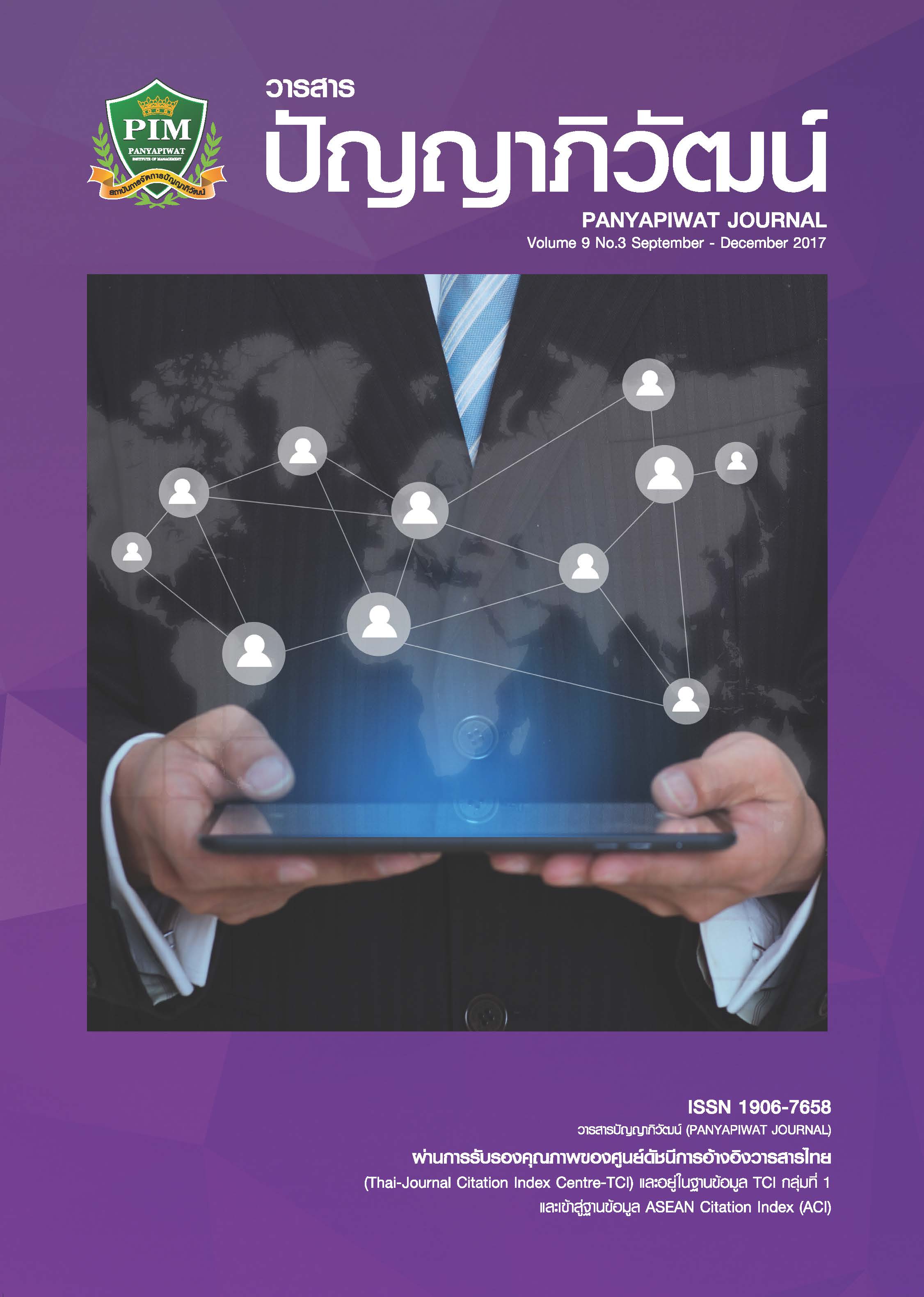ตัวแบบความสัมพันธ์ระหว่างความสุขในการทำงานและความผูกพันต่อองค์กร
Main Article Content
บทคัดย่อ
ด้วยความสุขในการทำงานเป็นประโยชน์ต่อองค์กรในการพัฒนาประสิทธิภาพในการทำงาน และสร้างความยั่งยืนในการดำเนินงานให้กับองค์กร รวมถึงสร้างความผูกพันต่อองค์กรของพนักงาน ซึ่งเป็นการช่วยธำรงรักษาพนักงาน การวิจัยนี้จึงมีวัตถุประสงค์เพื่อตรวจสอบและพัฒนาตัวแบบความสัมพันธ์ระหว่างความสุขในการทำงานและความผูกพันต่อองค์กรของพนักงานในองค์กรในนิคมอุตสาหกรรมภาคตะวันออกกับข้อมูลเชิงประจักษ์ อันเป็นการศึกษาความสัมพันธ์ของตัวแปรต่างๆ ที่เกี่ยวข้องในการพัฒนาองค์กรไปสู่องค์กรสุขภาวะในเชิงประจักษ์ รวมถึงเป็นการยืนยันความสัมพันธ์ในเชิงทฤษฎี โดยเก็บรวบรวมข้อมูลจากพนักงานขององค์กรที่เป็นภาคีเครือข่ายองค์กรสุขภาวะ และเป็นองค์กรต้นแบบด้านองค์กรสุขภาวะ จำนวน 400 ชุด ใช้การสุ่มตัวอย่างแบบแบ่งกลุ่ม และใช้การวิเคราะห์สมการเชิงโครงสร้างในการวิเคราะห์ข้อมูล ผลการศึกษาพบว่า การรับรู้การพัฒนาองค์กรสุขภาวะมีอิทธิพลทางตรงต่อคุณภาพชีวิตในการทำงาน รวมถึงคุณภาพชีวิตในการทำงานมีอิทธิพลทางตรงต่อความผูกพันต่อองค์กรและความสุขในองค์กรอย่างมีนัยสำคัญทางสถิติ และเมื่อพิจารณาความสอดคล้องของแบบจำลองความสัมพันธ์พบว่า แบบจำลองความสัมพันธ์มีความสอดคล้องกับข้อมูลเชิงประจักษ์
According to work happiness is beneficial to the organization in performance improvement and organization sustainability, including an organizational commitment that associated with employee retention, this research aimed to determine the casual model of employee work happiness and organizational commitment in eastern industrial estate as well as investigate the casual model consistency with empirical data. The author collected data from 400 employees of the enterprises that were happy workplace role model in eastern happy workplace network and employed cluster random sampling to select a sample and used the structural equation analysis (SEM) to analyze the data. The study indicated the perception of happy workplace development was significant directly affect to quality of work life, including quality of work life has significant directly affect to organizational commitment and work happiness. When regarding in casual model consistency, the causal model consistent with the empirical data.
Article Details
“ข้าพเจ้าและผู้เขียนร่วม (ถ้ามี) ขอรับรองว่า บทความที่เสนอมานี้ยังไม่เคยได้รับการตีพิมพ์และไม่ได้อยู่ระหว่างกระบวนการพิจารณาลงตีพิมพ์ในวารสารหรือแหล่งเผยแพร่อื่นใด ข้าพเจ้าและผู้เขียนร่วมยอมรับหลักเกณฑ์การพิจารณาต้นฉบับ ทั้งยินยอมให้กองบรรณาธิการมีสิทธิ์พิจารณาและตรวจแก้ต้นฉบับได้ตามที่เห็นสมควร พร้อมนี้ขอมอบลิขสิทธิ์บทความที่ได้รับการตีพิมพ์ให้แก่สถาบันการจัดการปัญญาภิวัฒน์หากมีการฟ้องร้องเรื่องการละเมิดลิขสิทธิ์เกี่ยวกับภาพ กราฟ ข้อความส่วนใดส่วนหนึ่งและ/หรือข้อคิดเห็นที่ปรากฏในบทความข้าพเจ้าและผู้เขียนร่วมยินยอมรับผิดชอบแต่เพียงฝ่ายเดียว”
เอกสารอ้างอิง
Chaiyasaeng, S. (2011). Relationship between Quality of Work Life toward Organizational Commitment of Ratchaphruek College’s Personnel. Bangkok: Ratchaphruek College. [in Thai]
Gordon, J. R. (1991). A Diagnostic Approach to Organization Behavior. Massachusetts: Simon & Schuster.
Hackman, R. J. & Suttle, L. J. (1977). Improving Life at Work: Behavior Science Approach to Organizational Change. California: Goodyear.
Huse, E. F. & Cummings, T. G. (1985). Organization Development and Change. Minnesota: West Publishing.
Kitivongprateep, G. (2007). Perception of Sufficiency Economy, Quality of Work Life and Work Happiness Employees: A Case Study of Employees in the Provincial Electricity Authority. Master’s thesis, Industrial and Organizational Psychology, Graduated School, King Mongkut’s University of Technology North Bangkok. [in Thai]
Kittisuksathit, S., Jamchan, C., Tangchontip, C. & Holumyong, C. (2013). Quality of Work Life, Work and Happiness. Nakorn Pathom: Institute for Population and Social Research. [in Thai]
Lebkrut, C. (2011). Quality of Work Life Affecting Organizational Engagement of Supporting Employees at National Institute of Development Administration. Bangkok: National Institute of Development Administration. [in Thai]
Miles, M. B. (1965). Education and Innovation: The organization in context. In M. Abbott and J. Love (Eds.). Changing Perspectives in educational administration. (pp. 54-72). Auburn: Auburn University.
Morarit, S. (2014). Quality of Work Life and Organizational Commitment of Health Personnel in the Regional Health Promoting Center 10 Chiang Mai. Lanna Public Health Journal, 10(1), 34-52. [in Thai]
Office of National Economic and Social Development Board. (2010). Direction of the 11th National Economic and Social Development Plan (Community Version). Bangkok: Office of National Economic and Social Development Board. [in Thai]
Pootachot, N. (2013). Organizational Behavior. Bangkok: V. Print (1991). [in Thai]
Promsri, C. (2011). The Modern Leadership. Bangkok: Expernet. [in Thai]
Rotniruttikul, N. (2011). The Characteristics of Healthy Organization. Technical Education Journal, 9(1), 228-234. [in Thai]
Saritwanich, S. (2009). Modern Organizational Behavior: Concept and Theory. Pathumtani: Thammasat University Publishing. [in Thai]
Scholl, R. W. (2003). Human Resource Strategies: Commitment and Control Approaches to Workforce Management. Retrieved April 3, 2003, from https://www.cba.uri.edu/Scholl/Notes/ Commitment_Control.html
Siratirakul, L., Uppor, W. & Pongcharoen, C. (2011). Quality of Work Life and Work Happiness among Nursing Instructors in Colleges of Nursing, Praboromarajchanok Institute, Ministry of Public Health. Journal of Phrapokklao Nursing College, 24(1), 10-21. [in Thai]
Steers, R. M. (1991). Introduction to Organizational Behavior. New York: Harper Collins Publishers.
Strellioff, W. K. (2003). Engaged Employees. Retrieved December 12, 2006, from https://bcauditor.com/PUBS/2002-03/Report1/sec2.htmUTH
Sukhanakin, S. (2006). Factors Relate to Happiness of People in Ampur Ta-Pla, Uttaradit Province. Master’s Thesis, Local Research and Development, Uttaradit Rajabhat University. [in Thai]
Tantithanadamrong, P. (2011). Quality of Work Life and Organizational Commitment of Kasikorn Leasing Company Limited. Master’s Thesis, Business Administration, Graduates School, Maejo University. [in Thai]
Thammakul, D. (2012). Developing Healthy Organization. Journal of Health Science Research, 6(1), 1-10. [in Thai]
Thammakul, D., Keawdumkeang, K. & Prasetsin, A. (2013). Developing Indicators of Healthy Organization. Journal of Health Science Research, 5(2), 8-19. [in Thai]
Thepwan, P. (2011). Human Resource Management. Bangkok: Se-education. [in Thai]
Walton, R. E. (1973). Quality of Working Life: What is it? Sloan Management Review, 15(1), 12-16.
Wasantanarut, C., Dungkota, C. & Tikeawsri, N. (2013). Building Happy Workplace. Bangkok: Thai Health Promotion Foundation. [in Thai]
Wattanaworasakul, P. (2008). Factors predicting the well-being of public and private organization employees in Mueang District, Chiang Mai Province. Master’s Thesis, Industrial and Organizational Psychology, Chiang Mai University. [in Thai]
Wongsureerat, C. (2011). The Relationships between Quality of Working Life, Happiness at Work, and Flow State as Moderator: Case Study in an Engineering, Procurement, Installation and Commissioning (EPIC) Company in Oil and Gas Business Industrial, Bangkok Office.Master’s Thesis, Industrial and Organizational Psychology, Faculty of Liberal Arts, Thammasat University. [in Thai]


